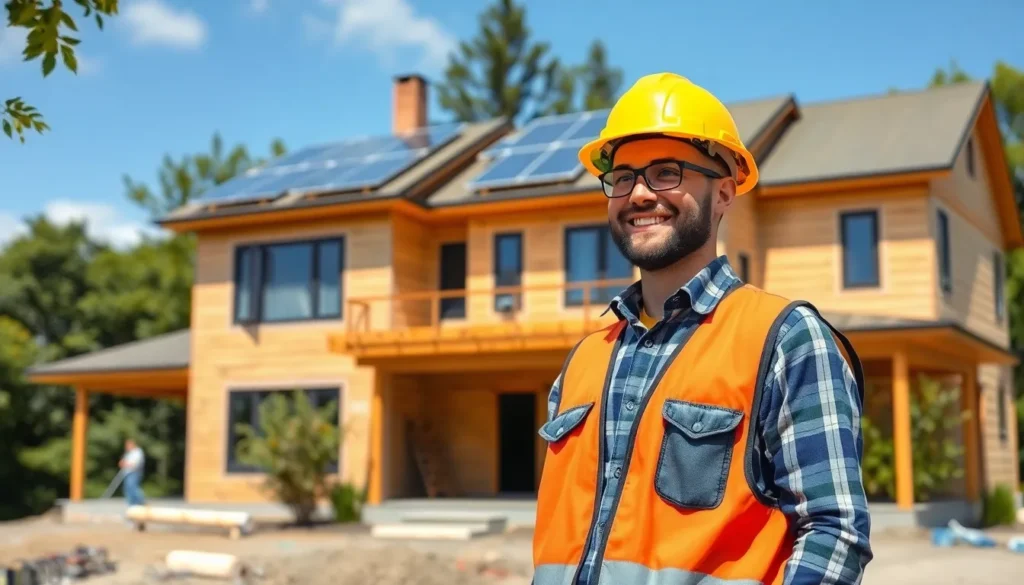Table of Contents
ToggleIn a world where the planet’s health hangs by a thread, sustainable apartment living isn’t just a trend; it’s a lifestyle choice that’s as chic as it is responsible. Imagine sipping your morning coffee while knowing that the energy powering your cozy abode comes from renewable sources. It’s like living in a Pinterest board where eco-friendly meets fabulous!
Understanding Sustainable Apartment Living
Sustainable apartment living emphasizes eco-friendly practices that minimize environmental impact while enhancing the quality of life. It encompasses various aspects, including energy efficiency, sustainable materials, and waste reduction.
Energy Efficiency
Energy-efficient apartments utilize high-quality insulation, energy-saving appliances, and smart technology. These features lower utility bills and reduce carbon footprints. For example, LED lighting and Energy Star-rated appliances consume less energy compared to standard options.
Sustainable Materials
Choosing sustainable materials for construction and furnishings contributes to healthier indoor environments. Bamboo flooring, recycled materials, and non-toxic paints exemplify sustainable choices. These materials reduce resource depletion while enhancing aesthetic appeal.
Waste Reduction
Implementing waste reduction strategies, such as recycling and composting, promotes responsible waste management. Apartments with recycling programs encourage residents to participate actively. Community gardens or composting initiatives provide additional avenues for minimizing waste.
Water Conservation
Sustainable apartments also prioritize water conservation through low-flow fixtures and drought-resistant landscaping. These measures help decrease water usage, conserve resources, and protect local ecosystems.
Community Engagement
Sustainable living fosters a sense of community among residents. Organizing events such as workshops on eco-friendly practices or local clean-up days strengthens bonds while promoting a sustainable lifestyle.
Incentives for Sustainable Living
Many property owners now offer incentives for sustainable practices, such as reduced rent for energy-efficient upgrades or subsidies for public transportation. These incentives motivate residents to embrace environmentally friendly habits.
Sustainable apartment living combines modern conveniences with environmental responsibility, appealing to conscious residents. This lifestyle choice supports individual well-being and contributes positively to the planet.
Benefits of Sustainable Apartment Living

Sustainable apartment living offers numerous advantages, from reducing environmental impact to providing financial savings.
Environmental Impact
Sustainable apartment living significantly lowers ecological footprints. Energy-efficient appliances and systems reduce electricity demand, minimizing greenhouse gas emissions. Utilizing renewable energy sources, such as solar panels, contributes to cleaner air and reduces reliance on fossil fuels. Eco-friendly materials enhance indoor air quality and create healthier living spaces. Implementing water conservation measures, like rainwater harvesting, conserves precious resources. Active participation in recycling and composting programs encourages responsible waste management and reduces landfill contributions. Overall, sustainable living promotes biodiversity while positively influencing communities and ecosystems.
Financial Savings
Sustainable apartment living leads to substantial financial savings. Energy-efficient designs and appliances result in lower monthly utility costs, allowing residents to allocate funds elsewhere. Utilizing smart technology for energy management optimizes energy use, leading to further reductions in expenses. Many states and local municipalities offer financial incentives, such as tax breaks and rebates, for energy-efficient home upgrades. Reduced water consumption translates into smaller water bills, benefitting residents financially. Additionally, strong community ties fostered by sustainable practices can create resource-sharing networks that further decrease living costs. Through these combined strategies, occupants enjoy a more affordable lifestyle.
Key Features of Sustainable Apartments
Sustainable apartments embody several essential features that enhance both environmental impact and resident comfort. These elements address energy use, resource conservation, and material sustainability.
Energy Efficiency
Energy-efficient apartments minimize energy consumption through advanced insulation and smart technology. Features like high-performance windows and energy-saving appliances lead to reduced utility bills and lower greenhouse gas emissions. Apartments may incorporate programmable thermostats and energy management systems, enabling residents to monitor and optimize their energy usage effectively. By using renewable energy sources, such as solar panels, residents contribute to cleaner air while enjoying modern conveniences without compromising their ecological footprint.
Water Conservation
Water conservation plays a vital role in sustainable apartments, employing fixtures and landscapes designed to reduce water usage. Low-flow faucets, showerheads, and toilets minimize water waste without sacrificing performance. Drought-resistant landscaping utilizes native plants that require less irrigation, further conserving water resources. Rainwater harvesting systems allow residents to collect and reuse rainwater for irrigation and non-potable applications. These practices not only contribute to environmental sustainability but also lead to lower water bills for residents.
Sustainable Materials
Sustainable apartments prioritize the use of eco-friendly materials that promote healthier living environments. Building components, such as bamboo flooring, recycled steel, and reclaimed wood, reduce the ecological impact associated with traditional materials. Non-toxic paints and finishes enhance indoor air quality, benefiting residents’ health. Sustainable construction practices incorporate renewable resources while ensuring durability and aesthetic appeal, creating spaces that reflect modern design while adhering to environmental standards. These materials contribute to a responsible lifestyle without compromising style or comfort.
Tips for Implementing Sustainable Practices
Implementing sustainable practices in apartment living is achievable with intentional choices and mindful actions. Residents can create eco-friendly environments while enhancing their quality of life.
Reducing Waste
Reducing waste involves adopting practices that minimize trash production. Residents can compost organic materials, diverting food scraps from landfills. Participating in recycling programs for plastics, paper, and metals significantly decreases waste. Utilizing bulk purchasing for groceries reduces packaging waste. Additionally, opting for reusable items, such as water bottles and shopping bags, limits single-use items. Organizing community swap events allows residents to exchange unwanted items, fostering a culture of reuse.
Choosing Eco-Friendly Products
Choosing eco-friendly products contributes to healthier living environments. Residents can select non-toxic, sustainable cleaning supplies that prevent harmful chemical exposure. Purchasing energy-efficient appliances reduces electricity consumption and lowers utility costs. Opting for furniture made from recycled materials or sustainably sourced wood supports responsible manufacturing practices. Selecting organic textiles for curtains and bedding eliminates harmful pesticides in production. Supporting local businesses promotes sustainable practices within the community, further encouraging responsible consumer behavior.
Embracing sustainable apartment living is a powerful way to contribute to environmental health while enjoying modern comforts. This lifestyle not only enhances personal well-being but also fosters a sense of community among like-minded individuals. By prioritizing eco-friendly practices residents can reduce their carbon footprints and lower utility costs, creating a win-win situation.
As the demand for sustainable living grows, property owners are increasingly offering incentives that encourage responsible habits. This shift towards greener living spaces reflects a broader societal commitment to sustainability. Ultimately, choosing to live sustainably is more than just a trend; it’s a meaningful step toward a healthier planet for future generations.







